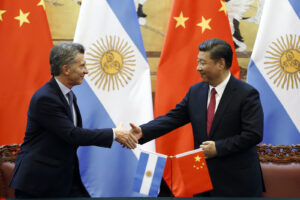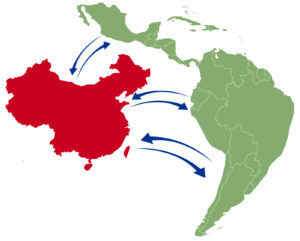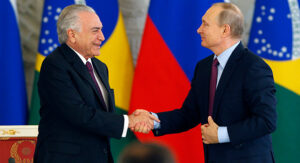
BEIJING, CHINA – MAY 17: Chinese President Xi Jinping and Argentina’s President Mauricio Macri attend a signing ceremony at the Great Hall of the People on May 17, 2017 in Beijing, China. Macri is on a state visit to China after attending the Belt and Road Forum. (Photo by Damir Sagolj/Pool/Getty Images)
China

Starting in the 1990s, the Chinese president came up with a new ideology called “going out” policy. China then joined the World Trade Organization in 2001, which changed the way China operated with foreign partners. China immediately jumped into Latin America, becoming Cuba and the Dominican Republic’s biggest partner, surpassing the US. Specifically, China began exporting different types of items like cell phones, clothes, or computers to Latin America despite some Latin American countries not formally recognizing the Chinese government. There is a political influence behind China’s involvement within Latin America though, as China is trying to shift its support from Taiwan to the Chinese government. Many nations have shifted their ideologies, such as the Dominican Republic, El Salvador, and Panama.
In terms of money, nineteen Latin American countries have joined the Chinese Belt and Road Initiative, a one trillion dollar transcontinental trade and infrastructure network. China is currently South America’s largest trading partner and supplies many loans to Latin America. Between 2005 and 2020, China loaned $137.0 billion USD to Latin American governments, often in exchange for oil and to fund energy and infrastructure projects. Venezuela is the biggest borrower; it’s taken on loans worth $62.0 billion USD since 2007, mainly tied to oil sales. The loans were given with the intent to support the oil industry. With the two tied together through the oil industry, it produced a massive boom for both economies.
All is done through means to continue to isolate Taiwan through political influence and exert dominance in south by south cooperation. South by south cooperation is development focused on aid, investment, and trade. Loans in other countries consist of $18.4 billion USD to Ecuador and $17.1 billion USD to Argentina. These loans were mostly provided under three characteristics that the Chinese government was looking for. Those are how each country has raw materials and domestic markets for Chinese manufactured goods, how each country had limited access to international credit institutions, and lastly, how each has dealt with an authoritarian leader. To help reduce financial risk with these loans, they were tied to commodities such as oil. The direct overseas investment cost is $17 billion USD. China’s state firms are major investors in the region’s energy, infrastructure, and space industries, and the country has surpassed the United States as South America’s largest trading partner.
For COVID, by late October of 2020, China had provided over 179 billion masks, 1.73 billion protective suits, and 543 million testing kits to 150 countries and seven international organizations around the globe.
Russia
With Russia breaking onto the scene in Latin America in the mid-2000s, the Russians held the idea of how they were not Americans close while making policy decisions. In order to do so, the Russians started early by differing from the American norm, by pushing out military prowess, propaganda, new banking systems, and cryptocurrencies. Military prowess, propaganda, new banking systems, and the installment of cryptocurrencies can mainly be seen in Venezuela. Russia is involved mainly in Venezuela, as the Russian government sees Venezuela as an opportunity to take advantage of the political climate in the country. Russia mainly meddles in Venezuela due to the uncertainty of the government to exert political and economic influence. Russia gradually returned to Latin America in the mid-2000s, led by loans and arms sales to Venezuela in 2005. Venezuela had to acquire loans to receive Russian military equipment ($4 billion USD). From 2006 to 2016, Russia’s trade with Latin America increased by 44% to $12 billion USD, and approximately half of Moscow’s trade deals were concentrated in Brazil, Mexico, and Venezuela.
In November 2017, Russia agreed to refinance $3.15 billion USD in bilateral loans and delay almost all payments until after 2023 in Venezuela. Russia sold over $11 billion USD in arms to Venezuela, including T-72 tanks, BMP-3 and BTR-80 armored vehicles, Su-30 fighters, Mi-17 and Mi-35 helicopters, and other military end items, making Venezuela by far Russia’s largest military partner in the region. State-controlled Russian oil giant Rosneft has invested heavily in Venezuela’s oil and gas sector. In November 2017, the Russian government agreed to restructure approximately $3 billion USD in loans to help ease Venezuelan debt. Russia has been making diplomatic overtures to countries like Nicaragua, Venezuela, Cuba, Brazil, and Argentina as well, which has been through economic influence as well as trade partnerships.

Russian President Vladimir Putin (R) shakes hands with his Brazil’s counterpart Michel Temer after their meeting at the Kremlin in Moscow on June 21, 2017. / AFP PHOTO / POOL / Sergei Chirikov (Photo credit should read SERGEI CHIRIKOV/AFP/Getty Images)
Recent Comments